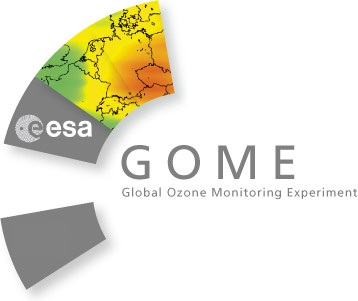
GOME

The Global Ozone Monitoring Experiment (GOME) was launched on April 21st 1995 on board the second European Remote Sensing Satellite (ERS-2). This instrument can measure a range of atmospheric trace constituents, with the emphasis on global ozone distributions.
GOME is a nadir-viewing spectrometer that measures the solar radiation scattered by the atmosphere in the ultraviolet and visible spectral region (240 to 790 nm). The sensor has a high spectral resolution of 0.2 to 0.4 nm sensed by four individual linear detector arrays each with 1024 detector pixels. The field of view may be varied in size from 320 km x 40 km to 960 km x 80 km. For further information and the mission objectives see the sensor information sheet.
GOME level-1 (radiances / reflectances) and level-2 (trace
gas amounts) products are computed from level-0 (raw) data using the GOME
Data Processor (GDP) system which was designed and developed by the German
Remote Sensing Data Center (DFD) of DLR in cooperation with the Institute of
Remote Sensing (University of Bremen/Germany), the Smithonian Astrophysical
Observatory (Harvard, Cambridge/MD, USA), the University of Heidelberg (Germany),
the Koninklijk Nederlands Meteorologisch Instituut (KNMI, The Netherlands),
and other institutions involved in the GOME Science Advisory Group.
GDP is the only operational off-line ground segment of the GOME sensor. The
operational processing of GOME data is done at the German D-PAF which is part
of DFD. For details about the quality of the level-1/-2 product refer to the
disclaimer document or the
GOME Quality Survey pages
as provided by BIRA-IASB
(Belgian Institute for Space Aeronomy) and UT-LAP
(University of Thessaloniki).
On December 15, 2004 GOME Level 2 data have been released with GDP version 4.0.
New Data Release: Version 4 - Reaching the Accuracy of Ground-Based Measurements with GDP 4.0
A short overview on how to access GOME can be found here
GOME DLR Near-Real-Time Service: Ozone, Nitrogen Dioxide, Clouds, Radiances and GOME Trajectory
- For an overview about GOME data products processed at DFD and methods of accessing them see the GOME Product Survey.
- A Product Specification Document of GDP for Level 1 and Level 2 products is available as a PDF file by clicking here.
- The User Manual is now avalable for the GDP Extractor software: click here for the PDF file.
- Information on the degredation of the GOME instrument: click here for the PDF file.
- News and information on GOME from ESRIN, ESA's European Space Research Institute, located in Frascati, Italy.
- The GOME Page of the Institute of Remote Sensing (University of Bremen), Principal Investigator of GOME.
- SAO, Smithsonian Center for Astrophysics, scientific support.
- We gratefully acknowledge the contributions of the following institutions to the development and ongoing improvements of the GOME Data Processor:
- European Space Agency (ESA)
- Deutsche Agentur für Raumfahrtangelegenheiten (DARA)
- Belgian Institute of Space Aeronomy, Brussels (BISA-IASB)
- Goddard Space Flight Center (NASA-GSFC)
- Harvard Smithsonian Astrophysical Observatory, Cambridge (SAO)
- Istituto per lo Studio delle Metodologie Geofisico Ambientali - Consiglio Nazionale delle Ricerche, Modena (IMGA-CNR)
- Max Planck Institute for Chemistry, Mainz (MPI Mainz)
- Royal Dutch Meteorological Service, DeBilt (KNMI)
- Rutherford Appleton Laboratory, Oxford (RAL)
- Space Research Organisation of the Netherlands, Utrecht (SRON)
- TNO/TPD, Delft
- University of Bremen, (IFE/IUP)
- University of Heidelberg, Heidelberg (IUP)
If you would like to have more information about the GOME 2 data, please contact wdc@dlr.de.